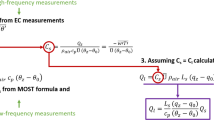Abstract
The temporal development of the profiles of potential temperature and specific humidity in a convection layer is predicted. The profiles satisfy the equations for the conservation of heat and total water. The convection is supported by a field of thermals which rise from the surface. Incipient cloud forms by condensation in thermals which rise above the convection layer and intrude into the overlying stable region. Model predictions are compared with laboratory experiments and field observations.
Similar content being viewed by others
References
Abraham, G.: 1967, ‘Jets with Negative Buoyancy in Homogeneous Fluid’,J. Hydraul. Res. 5, 235–248.
Abraham, G. and Eysink, W. D.: 1969, ‘Jets Issuing into Fluid with a Density Gradient’,J. Hydraul. Res. 7, 145–175.
Betts, A. K.: 1973, ‘Non-precipitating Cumulus Convection and its Parameterization’,Quart. J. Royal Meteorol. Soc. 99, 178–196.
Clarke, R. H., Dyer, A. J., Brook, R. R., Reid, D. G., and Troup, A. J.: 1971, ‘The Wangara Experiment: Boundary Layer Data’, CSIRO Div. of Meteorol. Phys. Tech. Paper No. 19.
Coulman, C. E.: 1978, ‘Boundary Layer Evolution and Nocturnal Inversion Dispersal - Part II’.Boundary-Layer Meteorol. 14, 493–514.
Coulman, C. E. and Warner, J.: 1977, ‘Temperature and Humidity Structure of the Sub-cloud Layer over Land’,Boundary-Layer Meteorol. 11, 467–484.
Deardorff, J. W., Willis, G. E., and Lilly, D. K.: 1969, ‘Laboratory Investigation of Non-steady Penetrative Convection’,J. Fluid Mech. 35, 7–31.
Hamming, R. W.: 1962, ‘Numerical Methods for Scientists and Engineers’, McGraw-Hill.
Hildebrand, F. B.: 1965, ‘Methods of Applied Mathematics’, 2nd ed., Prentice-Hall.
Hindmarsh, A. C.: 1974, ‘Gear: Ordinary Differential Equation System Solver’, Lawrence Livermore Laboratory, Report UCID-30001 Rev. 3.
Manton, M. J.: 1978a, ‘On Dry Penetrative Convection’,Boundary-Layer Meteorol. 14, 301–322.
Manton, M. J.: 1978b, ‘A Finite Element Model of a Moist Atmospheric Boundary Layer: Part I-Model Equations’,Tellus. 30, 219–228.
Morton, B. R.: 1957, ‘Buoyant Plumes in a Moist Atmosphere’,J. Fluid Mech. 2, 127–144.
Turner, J. S.: 1969, ‘Buoyant Plumes and Thermals’,Ann. Rev. Fluid Mech. 1, 29–44.
Turner, J. S.: 1973, ‘Buoyancy Effects in Fluids’, Cambridge Univ. Press.
Warner, J.: 1963, ‘Observations Relating to Theoretical Models of a Thermal’,J. Atmos. Sci. 20, 546–550.
Warner, J. and Telford, J. W.: 1967, ‘Convection Below Cloud Base’,J. Atmos. Sci. 24, 374–382.
Author information
Authors and Affiliations
Rights and permissions
About this article
Cite this article
Manton, M.J. Moist penetrative convection and the formation of incipient cloud. Boundary-Layer Meteorol 15, 265–287 (1978). https://doi.org/10.1007/BF02652601
Received:
Published:
Issue Date:
DOI: https://doi.org/10.1007/BF02652601




